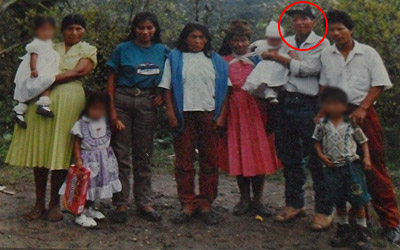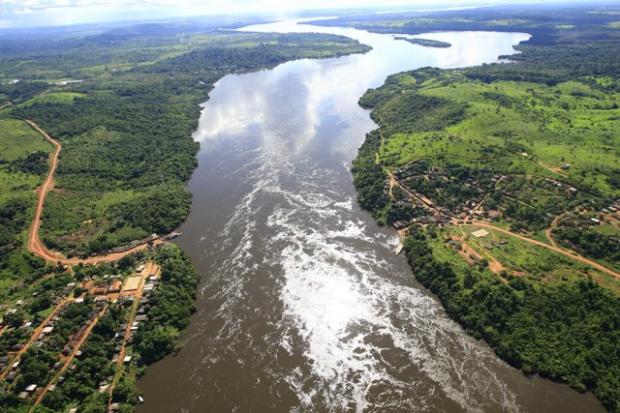
by Deep Green Resistance News Service | Aug 17, 2012 | Colonialism & Conquest, Indigenous Autonomy
By Survival International
A 74-year-old Nasa Indian leader has been shot dead following protests against the militarization of his land in Cauca, south-west Colombia.
Lisandro Tenorio, a traditional healer, was at home with his family when two unidentified men arrived, shook his hand, and shot him three times in the head.
The Nasa made international headlines last month when they forcibly expelled soldiers from a military base on their land.
Illegal armed guerrillas of Colombia’s rebel group, the FARC, were also confronted by the Nasa and ordered to leave their territory within days.
Colombia’s army have been battling with the rebels for decades, with the Nasa caught in the violent crossfire.
According to Lisandro’s family, he had been repeatedly threatened by the FARC, who have been blamed for his death.
Survival has been campaigning against violence in Cauca since 1974, and has supported its regional indigenous organization CRIC.
Yesterday, CRIC released a statement that said, ‘Members of the FARC, stop your war. Our people are tired of so much humiliation and accusation. To kill an indigenous traditional healer is to put an end to the knowledge, soul, and wisdom of a people’.
From Survival International: http://www.survivalinternational.org/news/8587

by Deep Green Resistance News Service | Aug 15, 2012 | Climate Change, Obstruction & Occupation
By Will Wooten / Waging Nonviolence
One year after more than 1,200 people were arrested in front of the White House during two weeks of sit-ins against the Keystone XL tar sands oil pipeline, a coalition of Texas landowners and activists will attempt to physically halt its construction. Led by veteran climate justice organizers, participants ranging from environmentalists to Tea Partiers are preparing to lock arms for a sustained nonviolent civil disobedience campaign, beginning perhaps as early as this week.
The impetus for such action, which is being called the Tar Sands Blockade, goes back much further than last summer, however. In 2008 and 2009, small landowners along the pipeline’s route in rural Texas, Oklahoma and Nebraska started noticing survey stakes with orange tape marked “KXL.” They soon found out that TransCanada — the company building the pipeline — had eminent domain power over their property and that if they didn’t sign a contract allowing TransCanada to build, they would be taken to court.
Many landowners, feeling pushed into an impossible situation, signed the contracts. Some began organizing, doing community outreach to explain what was happening and building conservative support on the ground. Organizations such as Nacogdoches Stop Tarsands Oil Pipelines evolved out of conversations between landowners — first focusing around eminent domain, but then, when they learned that tar sands oil would be pumped through the pipeline, discussion started to include environmental impacts, such as toxic diluted bitumen and climate change.
By August 2011, the climate movement in the United States started to focus in on the Keystone XL with Tar Sands Action, a civil disobedience campaign led by Bill McKibben and members of 350.org. The 1,253 arrests in front of the White House helped raise the issue to a national level by stressing that President Obama could stop the pipeline by rejecting its permit to cross the U.S.–Canada border.
Weeks later, the Occupy movement emerged. While environmental issues were not at the forefront, many Occupy encampments passed resolutions opposing Keystone XL and took part in Tar Sands Action’s next rally in Washington, D.C., when, on November 6, 12,000 people encircled the White House. Days later President Obama denied the permit and, for the moment, Keystone XL was thought dead.
TransCanada then changed tactics and decided to split the pipeline into segments so that it could get a head start on construction while making inside deals in Washington to secure the necessary permit for crossing the border. In a sign of goodwill to the fossil fuel industry, President Obama went to Cushing, Oklahoma, and declared that he would “expedite” the permitting process for the Gulf Coast segment from Cushing to Houston and Port Arthur, Texas. While that ability was technically outside of his reach, it was a hint to the agencies responsible for such decisions. Perhaps not surprisingly, the Army Corps of Engineers then granted the three permits TransCanada needed to start construction — despite the absence of an environmental review.
The southern segment of the Keystone XL will be built in three different sections, simultaneously, with the goal of transporting tar sands oil currently stored in Cushing, Oklahoma, to refineries on the Gulf Coast, where it then can be shipped around the world. When Texas activists such as myself learned that this was happening despite the Tar Sands Action victory, we decided to form Tar Sands Blockade.
While landowners began organizing along the pipeline route in early 2012, climate justice activists with Rising Tide North Texas were looking for ways to bring wider attention to the pipeline’s impending construction. Many of us had been active Occupiers during the encampments and were disappointed with the movement’s inability to make the connection between economic justice and the climate. So we made a stronger effort to engage people on the community level.
As a result, Tar Sands Blockade is being informed by a variety of voices — from self-identified Tea Party members, flying Gadsden flags at the front of their long driveways, to Occupiers who slept at encampments across the country.
Several organizers with Tar Sands Blockade also participated in and organized for Tar Sands Action, including veteran climate justice activists from around the country. This diverse coalition has agreed on one simple call to action: The Keystone XL should not be built in Texas, and nonviolent direct action is required to stop it.
Other means of addressing the grievances of landowners and meeting the challenge of climate change have thus far failed. As Bill McKibben’s recent article “Global Warming’s Terrible New Math” made clear, the world has years, not decades, to confront the fossil fuel industry head on. Nonviolent direct action offers the best chance of victory, not just for the Tar Sands Blockade but for other fossil fuel extraction movements, such as those opposing fracking, mountaintop removal and coal exports — all of which have been active in what’s being called a Climate Summer of Solidarity.
That solidarity will take on greater meaning in a matter of days when construction on the pipeline is expected to begin and landowners will be bringing ice to the encampments to help alleviate the extreme Texas heat, as well as thanking everyone for defending the home they’ve built over decades. Activists will respond by holding the blockade for as long as possible, through the summer and likely into the fall. This could be an important moment for the entire climate movement, setting the stage for future actions and alliances — not to mention giving new meaning to the words “Don’t mess with Texas.”
From Waging Nonviolence: http://wagingnonviolence.org/2012/08/dont-mess-with-texas-tar-sands-blockade/

by Deep Green Resistance News Service | Aug 14, 2012 | Indigenous Autonomy, Lobbying
By Zachary Hurwitz / International Rivers
Federal Judge Souza Prudente of the Federal Tribunal of Brazil’s Amazon region suspended all work today on the Belo Monte Dam, invalidating the project’s environmental and installation licenses.
While the project has been suspended previously on numerous occasions, and those suspensions overturned on political grounds, this latest decision could have some legs. The decision breaks down in the following way:
- The federal judge ruled that no consultations were held with indigenous people prior to Congress issuing Decree 788 in 2005, which effectively approved the Belo Monte Dam. Article 231 of the Brazilian Constitution requires consultations to be held directly by the Congress prior to approval. In this case, approval was given three years before publication of the environmental impact assessment, after which consultations began.
- As a result, the project’s environmental license (granted in 2010) and installation license (granted in 2011) are now considered invalid, meaning that no further work can continue on the dam.
- Brazil’s National Congress must hold a series of public hearings, or consultations, with the indigenous tribes that will be affected by Belo Monte. Only after such consultations occur and are considered satisfactory, must the Congress legislate a new approval for the dam.
- The government and project consortium Norte Energia, S.A. can appeal to Brazil’s Supreme Court, Brazil’s Superior Court of Justice, the President of the Federal Tribunal, and Brazil’s Attorney General, in the next 30 days. Since this is a constitutional matter, the appeal is likely to go to the Supreme Court.
In a press conference given today late in Brasil, Souza Prudente stated that “only in a dictatorial regime does a government approve a project before holding consultations.”
The decision supports the arguments that the affected tribes have been making over the lifetime of Belo Monte: tribes will face downstream livelihood impacts as a result of a reduction in the flow of the Xingu River on the 100-km stretch known as the Volta Grande or “Big Bend,” and were never properly consulted, much less gave their consent.
In the words of the decision itself,
“installation will cause direct interference in the minimal ecological existence of the indigenous communities, with negative and irreversible impacts on their health, quality of life, and cultural patrimony, on the lands that they have traditionally occupied for time immemorial. This requires the authorization of the National Congress after holding prior consultations with these communities, as deemed by law, under the penalty of suspension of the authorization, which has been granted illegally.”
Beyond the fact that the Belo Monte Dam is now considered illegal by one of Brazil’s higher courts, the fact is that Brazil doesn’t need Belo Monte. Economic rationale for the dam is based on a projected economic growth of 5% or more a year, but over the past few quarters, GDP has been lucky to grow at even a measily rate. As far as Belo Monte’s importance to Brazil’s economic race, this is really a case of the horse following the wagon.
And, as illustrated by this historic court decision, the wagon has been trampling on indigenous people and their rights, along the way.
From International Rivers: http://www.internationalrivers.org/blogs/258/belo-monte-dam-suspended-by-high-brazilian-court
by Deep Green Resistance News Service | Aug 13, 2012 | Colonialism & Conquest, Indigenous Autonomy, Reclamation & Expropriation
By Survival
More than 50 gunmen have launched a full-scale attack on an Indian community in southwest Brazil, shooting, threatening and then reportedly kidnapping one of their leaders.
The violence began on Friday, shortly after the Guarani community reoccupied part of its ancestral land, which is now occupied by ranchers.
A Guarani spokesman described how 50 gunmen surrounded around 400 Indians, firing shots at them, whilst laughing and shouting, ‘You Indians! Today, not one of you Indians will get out of here alive!’
He says hundreds of shots were fired at the Guarani men, women and children, who fled into the forest to try to escape injury.
The Guarani say that one of their leaders, a man in his fifties, was taken by gunmen and put into a car. He has not been seen since but the burnt remains of some of his clothes have been discovered.
The shooting stopped hours later, when a police vehicle arrived at the scene. No arrests have been made.
The Guarani of Arroio Korá community have been living in makeshift roadside camps, and in overcrowded reserves, while they wait for the government to map out their land and return it to them.
Unable to further endure the appalling living conditions in the camps and reserves, the Guarani decided to march back to their ancestral land on Friday, after two days of traditional prayer and rituals.
A community member said on Saturday, ‘We are surrounded by gunmen. They could attack us again. They could kill us all!’
Last November, Guarani leader Nísio Gomes was shot dead by gunmen when his community reoccupied some of its land. They drove off with his body, which has yet to be found. Eighteen men have been arrested in connection with his murder.
The Guarani at Arroio Korá remain fearful but resolute, saying, ‘We will not be silenced in the face of the assassinations… and the violations of our indigenous and human rights’.
From Survival International: http://www.survivalinternational.org/news/8581

by Deep Green Resistance News Service | Aug 11, 2012 | Biodiversity & Habitat Destruction, NEWS
By US Geological Survey
From 1900-2010, freshwater fish species in North America went extinct at a rate 877 times faster than the rate found in the fossil record, while estimates indicate the rate may double between now and 2050. This new information comes from a U.S. Geological Survey study to be published in the September issue of the journal BioScience.
In the fossil record, one freshwater fish species goes extinct every 3 million years, but North America lost 39 species and 18 subspecies between 1898 and 2006. Based on current trends in threatened and endangered fish species, researchers estimate that an additional 53-86 species of freshwater fish may be extinct by the year 2050. Since the first assessment of extinct North American freshwater fishes in 1989, the number of extinct fishes increased by 25 percent.
“This study illustrates the value of placing current events into the context of deep geologic time, as rocks preserve an unbiased record of natural rates of processes before human activities began to alter the landscape, the atmosphere, the rivers, and oceans,” said USGS Director Marcia McNutt. “Freshwater fish are a good choice for analysis as their bones make clear fossil impressions, and their lake and river environments produce excellent stratigraphic sequences.”
The study’s author, Noel Burkhead, used an established method to compare the rate of extinction found in the fossil record with modern rates.
“Estimates of freshwater fish extinctions during the twentieth century are conservative, because it can take 20-50 years to confirm extinction,” said Burkhead, a research fish biologist for the USGS.
Extinction is a natural process, Burkhead explained, so examining its rate over a long geological timescale provides biologists with a benchmark for comparing current extinctions to background rate. The accelerated pace of extinction observed since the beginning of the twentieth century suggests human causes.
In North America, assessments of extinctions are conducted by the American Fisheries Society’s Endangered Species Committee, using categories to factor in a lag time since the last observation of the species. The study used the categories “extinct” (species not seen for 50 years or more), “possibly extinct” (not been seen for 20 years or more), and “extinct in nature.” All these categories require that searches for the missing fishes must have been made by knowledgeable biologists.
“It is extremely rare that the death of the last individual is documented by biologists,” said Burkhead, “although it can happen when a fish only is found in a specific spring or caldera, and it dries up. That’s what happened with five species of desert pupfishes and the Alberca silverside—the last known fish to go extinct in North America.”
The Alberca silverside was found only in the Alberca Caldera, Guanajuato, Mexico; it went extinct when the caldera temporarily dried up in August 2006.
Surprisingly, Burkhead reported that 90-96 percent of fish extinctions in the fossil record were not linked to the five well-known mass extinctions. Natural causes of fish extinction are linked to transitions in landforms and continental watercourses over time, but many twentieth century extinctions were caused by dams, channelization of rivers, water pollution, and other human-induced factors.
The background rate of extinction is based on the fossil record, which includes information on when ancient fishes lived and how long species survived in the geological past. Burkhead used data on fish extinctions from well-known paleontologist Steven M. Stanley at the University of Hawaii.
“Another cause of extinction can be a change in a fish’s food chain, which is what may have happened to the harelip sucker, a really cool fish that used to live in seven states throughout the Ohio River basin,” said Burkhead. “It was a snail-eating specialist with cleft lips that used to pluck snails off river bottoms and manipulate the snail in its mouth in order to suck out the snail’s soft parts, perhaps making little popping sounds. Sadly, snails are highly sensitive to excessive sedimentation and in the late nineteenth century, large amounts of topsoil were washing into rivers along with sewage and industrial effluents from cities. This likely caused snails to decline, which may have been what drove the fish to extinction.”
Declines in freshwater fishes are only the “tip of the iceberg” for freshwater ecosystems, with mussels and snails experiencing declines greater than that of freshwater fishes.
From US Geological Survey




